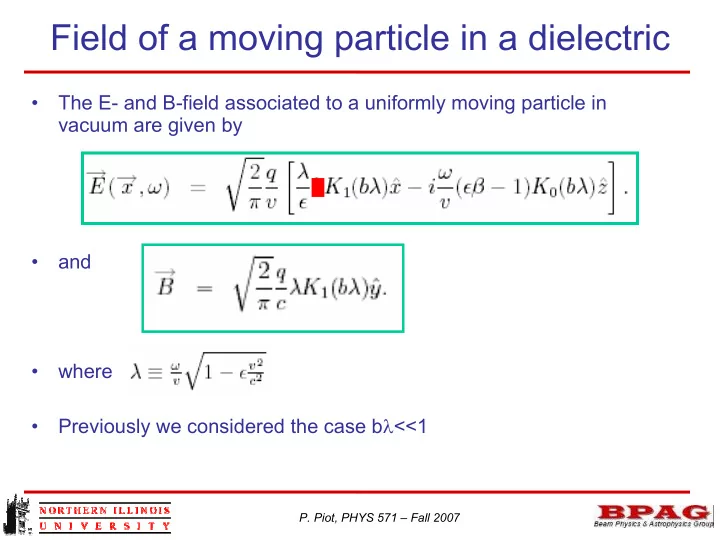

Field of a moving particle in a dielectric • The E- and B-field associated to a uniformly moving particle in vacuum are given by • and • where Previously we considered the case b λ <<1 • P. Piot, PHYS 571 – Fall 2007
Field in the limit b λ >>1 We now consider the extreme case b λ >>1. The modified Bessel • functions have the asymptotic expansion: • And the field associated to a uniformly moving charged particle takes the form P. Piot, PHYS 571 – Fall 2007
Cerenkov condition We saw that to get radiation (or energy loss) we needed either λ or ε • to be complex. • When investigating dielectric screening effects we considered the case ε ∈ C We now consider the case where λ is a pure imaginary number and ε • ∈ R. • from • …. P. Piot, PHYS 571 – Fall 2007
Cerenkov condition • Consider the model for permittivity ω=ω 0 ε 1/β 2 ε=1 ω ω 0 ω L P. Piot, PHYS 571 – Fall 2007
Energy loss • Explicit the asymptotic form of the e.m. field in the energy loss equation. • gives P. Piot, PHYS 571 – Fall 2007
Frank-Tamm energy loss formula But λ ∈ I so λ∗/λ =-1 so finally • • This is Frank-Tamm formula derived in 1937. • History: – Cerenkov observed the radiation in Vavilov’s labs (1934) – Frank and Tamm explained the effect (1937) – Cerenkov, Frank and Tamm share Nobel prize (1958) P. Piot, PHYS 571 – Fall 2007
Direction of propagation • The direction of the wave is given by k , k perpendicular to E and B . Let θ c be the angle between the velocity of the particle and k then Velocity of light in • From the considered medium P. Piot, PHYS 571 – Fall 2007
Shock wave feature • Cerenkov radiation consists of a shock wave • Effect similar to the Mach effect P. Piot, PHYS 571 – Fall 2007
Shock wave feature I • Cerenkov radiation consists of a shock wave • Effect similar to the Mach effect P. Piot, PHYS 571 – Fall 2007
Shock wave feature II • The Shock wave feature inferred geometrically can be derived from the wave equation • So A takes the same form as in vacuum under “renormalization” • So we can directly write the potentials as P. Piot, PHYS 571 – Fall 2007
Shock wave feature III • Consider • On another hand causality • So • Solve for (t-t’) : P. Piot, PHYS 571 – Fall 2007
Shock wave feature IV • For Cerenkov radiation (v>c m ), to obtain t-t’ real positive we need ζ .v>0 and ( ζ .v) 2 >(v 2 -c m 2 ) ζ 2 . • That is • So • Thus potentials and fields exist at time t only within a cone with apex lying at the present time position of the particle and apex angle P. Piot, PHYS 571 – Fall 2007
Shock wave feature V • The 4-potential is given by • The denominator is • Expliciting (t-t’) we gives P. Piot, PHYS 571 – Fall 2007
Shock wave feature VI • So finally the potentials are singularity • In practice the singularity is smeared by the frequency-dependence of ε(ω) which implies c m ( ω )… P. Piot, PHYS 571 – Fall 2007
Recommend
More recommend